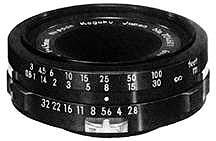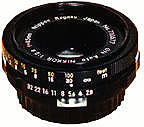| NOTE: In an attempt to revamp & rearrange content in this website, there is now a newly developed section featuring various MF Nikkor lenses, please bookmark the new site for future updates. As for SLR bodies, please refer to: - Nikkormat, Nikon EM/FG/FG20, FM series, FE Series, Nikon FA, Nikon F, Nikon F2, Nikon F3 & Nikon F4 |

Nikkor 45mm f/2.8 GN Auto
Nikkor
Honestly, I don't know what this lens is all about, until I
started to "gorek" (Dig and search in English) many places, including the
Internet to find more info on this lens, one or two shops on the net do sell this
lens and when I asked for more info.. no one can tell me. Finally found some useful
info in a Nikon's Sales & technical manual of the early sixties. This is to satisfy
my personal curiosity and I thought may be out there some other might have
the same problem sourcing for similar knowledge and thus I am uploading this page.
GN Auto Nikkor (The Auto repeated many times, it is so common that everyone is taking it for granted, but those days, an auto lens is like the fancy name tag like IF or CRC etc of current modern lenses) was designed to simplify flash photography (What ?) As its name implies, GN stands for Guide Number, the lens employs the guide number coupling system for auto diaphragm adjustments.
By setting the appropriate guide number on the scale of the lens, the diaphragm ring is hooked to the focusing ring, allowing the aperture to be stopped down or opened up automatically in relation to the focused distance to give a correct flash exposure. This frees up the photographer from troublesome calculation of the ideal exposure and read adjusting the lens diaphragm.
The guide number coupling can be disconnected when flash is not used. With its picture angle at 50°, it also can be used as a standard lens for general photography.
This lens is very simple in its optical structure, only 4 elements in 3 groups, apertures from the maximum of f2.8 to f32; 52mm filter mount. and it is still slim and compact: dimension at 64mm x 31mm length.
The lens is optimised at f8, where the 7 blades polygonal diaphragm were designed to form an almost circular aperture, which help to reduces the effect of light diffraction to the absolute minimum. It can stop down to f32 minimum. Used in combination with Nikon speedlight, in particular situation where the photographer has no time to reset the diaphragm.
All these may sound primitive to you when compared with any of the simple modern auto SLR of today. But that was how your current modern high-tech SLRs were develop and progressed from...

I Know is hard to visualise in grey scale,
and start hunting an image on color, got one... finally.
Back to index page
Home - Photography in Malaysia
A pictorial history of:
Nikon, Hasselblad, Rollei.
Back to Basic in photography or look forward
to the digital imaging ?
Interesting resources for photography.
![]()
[Left Brain][Right brain][Home-MIR]
[Invention][Art & Design][Newsdesk][Collectibles][Clubs]
[Portfolios][Camera Shops][Suppliers][On assignments]
[Pix of the week][Trading room][Knowledge & Resources]
[Free-trade-zone][Thoughts & opinions][Links]
Copyright © 1996 leofoo [member of the MIR Web Design Team.] All Rights Reserved. Created with a Power Macintosh.